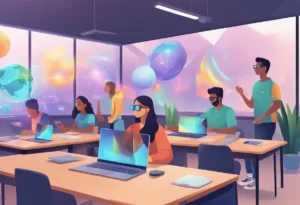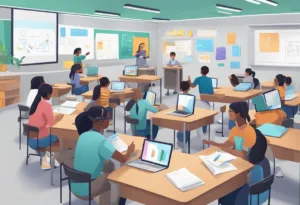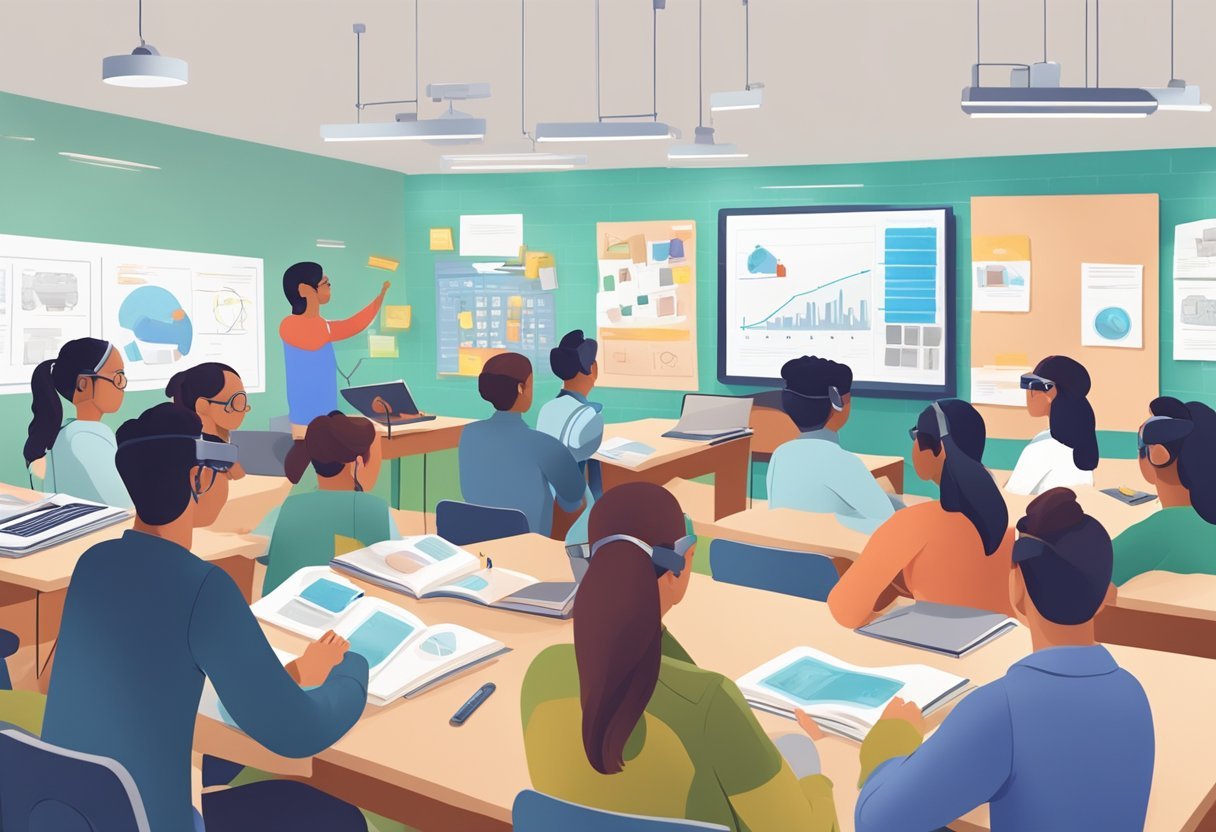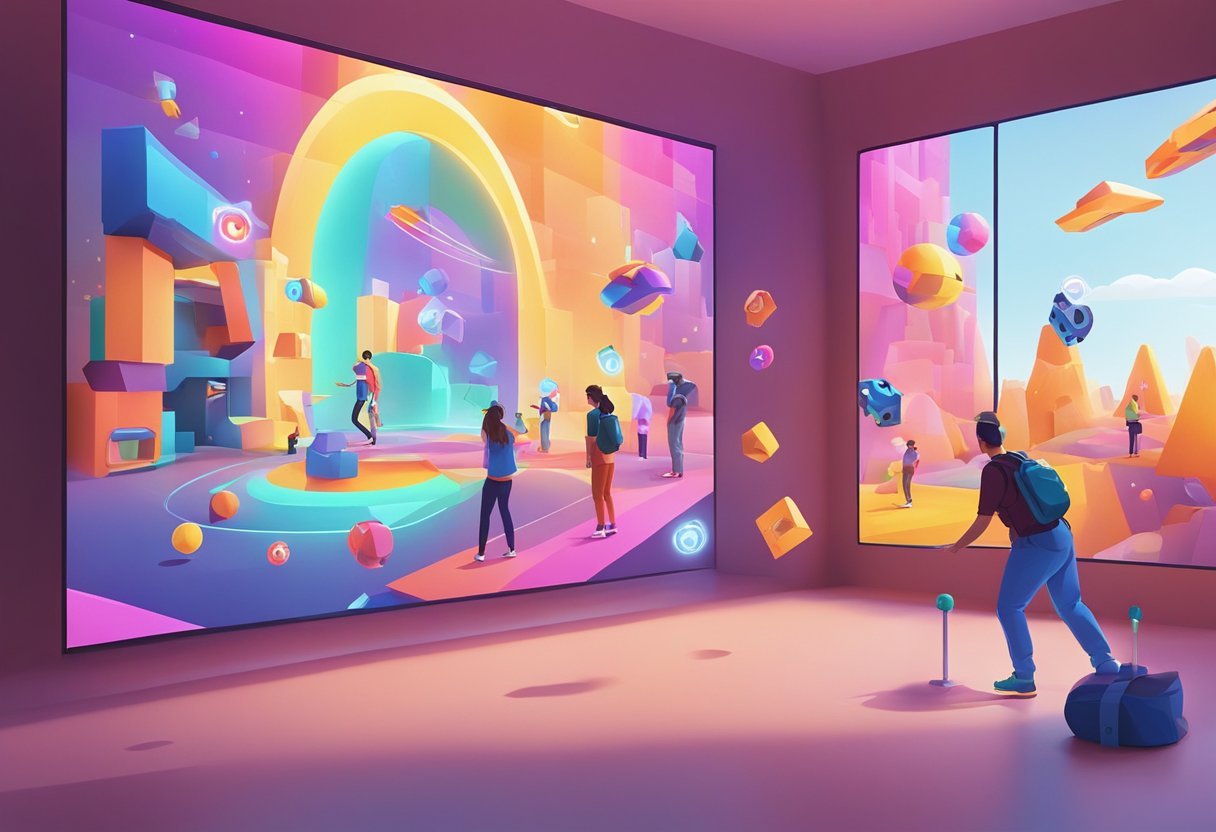Augmented reality (AR) is a technology that overlays digital information onto the real world, allowing users to interact with the environment in new and exciting ways. In recent years, AR has gained popularity in the education sector, with many higher education institutions incorporating AR into their curricula to enhance learning outcomes and engage students. By using AR, educators can create immersive and interactive learning experiences that help students understand complex concepts and retain information better. In this blog post, I will share with you the role of Augmented Reality in Higher Education and 10 use cases of AR in higher learning.
The use of AR in higher education has evolved significantly over the past few years, with advances in technology and hardware making it easier for educators to integrate AR into their courses. AR can be used for a variety of purposes, including virtual field trips, interactive textbooks, and simulations. With AR, students can explore subjects in new ways, visualize abstract concepts, and collaborate with peers to solve problems.
Historical Context and Literature Review
Augmented reality (AR) has been around for decades, but it is only in recent years that it has been applied to education. Early applications of AR were limited to military and industrial training, but as the technology evolved, it became more accessible to the general public. In recent years, AR has become a buzzword in education, and numerous studies have been conducted to investigate its potential benefits.
One of the earliest studies on AR in education was conducted in 2006 by the University of Canterbury. The study found that AR could be used to enhance the learning experience by providing students with a more immersive environment. Since then, many other studies have been conducted to investigate the effectiveness of AR in education.
From Virtual Reality to Mixed Reality
AR is often confused with virtual reality (VR), but the two are distinct technologies. VR is a fully immersive environment that is created using computer-generated imagery. AR, on the other hand, overlays virtual objects onto the real world. Mixed reality (MR) is a combination of both technologies, where virtual objects are seamlessly integrated into the real world.
In recent years, there has been a shift from VR to MR in education. MR provides a more realistic and immersive environment that can be used to enhance the learning experience. MR also allows for more interaction between students and virtual objects, which can lead to a deeper understanding of the subject matter.
Role of Augmented Reality in Higher Education
AR has the potential to revolutionize higher education by providing students with a more immersive and interactive learning experience. AR can be used to create 3D models of complex concepts, which can be explored in an immersive environment. AR can also be used to create virtual labs, which can be used to conduct experiments that would be too dangerous or expensive to conduct in real life.
Emerging technologies such as AR are driving innovation in higher education. AR has the potential to transform the way that students learn and interact with the world around them. As AR technology continues to evolve, it is likely that we will see more and more applications of AR in education.
Use Cases of Augmented Reality in higher education

- Medical and Anatomy Training
- Engineering and Design Visualization
- Historical Sites and Artifacts Exploration
- Language and Cultural Immersion
- Astronomy and Space Studies
- Environmental Science Simulations
- Interactive Lab Experiments
- Complex Data Visualization
- Architecture and Urban Planning
- Legal Education Mock Trials
Medical and Anatomy Training
Augmented reality offers a transformative approach to medical and anatomy training in higher education. With AR, students can visualize and interact with complex anatomical structures in three dimensions, offering a deeper understanding than traditional 2D images or textbooks. AR applications allow for the simulation of surgical procedures, providing a risk-free environment for students to practice and refine their skills. This hands-on approach not only improves the learning experience but also prepares students for real-world medical scenarios by providing them with a comprehensive understanding of human anatomy and the intricacies of medical procedures.
Engineering and Design Visualization
In engineering and design programs, augmented reality facilitates the visualization of mechanical components, structures, and systems in a real-world context. Students can see their designs come to life by overlaying CAD models onto physical spaces, enabling them to identify potential issues and make adjustments before the production phase. This interactive process enhances the learning experience by bridging the gap between theoretical knowledge and practical application, allowing students to experiment with designs in a collaborative and intuitive manner.
Historical Sites and Artifacts Exploration
Augmented reality can bring history to life for students by providing immersive experiences with historical sites and artifacts. By using AR technology, educators can transport students back in time to explore ancient civilizations, reconstruct historical events, and examine artifacts in detail without the need for physical travel. This technology can enrich history and archaeology courses, providing context and depth to the subject matter that might otherwise be abstract or difficult to visualize.
Language and Cultural Immersion
Language learning is greatly enhanced by cultural immersion, and augmented reality can simulate environments where students can practice new languages in contextual settings. AR can create virtual marketplaces, restaurants, or cityscapes where students must use their language skills to interact with the environment and its inhabitants. This method provides an engaging way to practice conversational skills and understand the cultural nuances of the language being studied.
Astronomy and Space Studies
Astronomy courses can benefit from augmented reality by providing students with an interactive map of the stars and planets. AR apps can overlay constellations and celestial bodies onto the night sky, helping students to learn and identify different space objects. Furthermore, AR can simulate space missions, allowing students to experience the challenges of space travel and exploration within the classroom setting.
Environmental Science Simulations
Environmental science students can use augmented reality to study ecosystems, climate change, and other ecological concepts in an interactive manner. AR can simulate different environments, such as rainforests or oceans, and demonstrate the impact of human activities on these ecosystems. This immersive approach not only educates students about environmental issues but also encourages them to think critically about sustainability and conservation efforts.
Interactive Lab Experiments
Augmented reality can transform the traditional laboratory setting by enabling students to conduct experiments virtually. AR lab simulations can mimic the effects of chemical reactions, physical changes, and biological processes without the need for physical materials or the risk of hazardous situations. This use of AR in laboratory experiments can provide a safe, cost-effective, and scalable solution for hands-on learning.
Complex Data Visualization
In fields such as data science, bioinformatics, or economics, understanding complex datasets is crucial. Augmented reality can visualize these datasets in three dimensions, making it easier for students to identify patterns, correlations, and outliers. This spatial representation of data can enhance the learning process by allowing students to interact with and manipulate data in a more intuitive way.
Architecture and Urban Planning
Students in architecture and urban planning can use augmented reality to project their models onto real-world landscapes, giving them a unique perspective on how their designs would interact with existing structures and environments. AR can facilitate the understanding of spatial relationships, scale, and the impact of architectural designs on their surroundings, providing a valuable tool for future architects and city planners.
Legal Education Mock Trials
For students pursuing legal education, augmented reality can simulate courtroom settings for mock trials. This technology can create a more realistic and engaging environment for students to practice litigation skills, such as presenting evidence, cross-examining witnesses, and delivering closing arguments. AR in legal education can help bridge the gap between theory and practice, preparing students for their future roles in the legal profession.
Technological Foundations and Hardware
When it comes to augmented reality (AR) in higher education, the technological foundations and hardware are essential components that enable the creation and delivery of immersive experiences. In this section, we’ll explore the different types of hardware and devices that are commonly used in AR applications, including headsets, sensors, smartphones, and mobile devices.
AR Devices: Headsets and Sensors
One of the most popular hardware devices for AR in higher education is headsets. These devices are worn on the head and allow users to experience immersive AR environments. There are several types of headsets available on the market, including the Microsoft HoloLens, which is a self-contained AR headset that uses sensors and cameras to track the user’s movements and create a 3D map of their environment. Other popular headsets include the Oculus Quest and the HTC Vive, which are primarily used for gaming but can also be used for educational purposes.
In addition to headsets, sensors are also an important component of AR hardware. These devices are used to track the user’s movements and create a 3D map of their environment. Some popular sensors include the Leap Motion Controller, which is a small device that can be attached to a headset or computer, and the Intel RealSense Depth Camera, which is a camera that can be used to capture depth information and create 3D models of objects.
Smartphone and Mobile Augmented Reality
Another popular type of hardware for AR in higher education is smartphones and other mobile devices. These devices are equipped with cameras and sensors that can be used to create AR experiences. One popular example of mobile AR is the Pokemon Go game, which allows users to capture virtual creatures in the real world using their smartphones.
Mobile AR can be used in a variety of educational contexts, such as virtual field trips, interactive textbooks, and language learning apps. Some popular mobile AR platforms include ARKit for iOS devices and ARCore for Android devices.
Te hardware and devices used in AR applications are critical components that enable the creation and delivery of immersive experiences. Whether you’re using headsets, sensors, or mobile devices, the right hardware can help you create engaging and interactive educational experiences that can enhance learning outcomes for students.
Curriculum Integration and Instructional Design

Augmented reality (AR) is a promising technology that can revolutionize higher education by providing students with immersive and interactive learning experiences. To effectively incorporate AR into the curriculum and instructional design, educators need to focus on two key areas: incorporating AR into STEM education and designing AR-enhanced learning activities.
Incorporating AR into STEM Education
AR can be used to enhance STEM education by providing students with hands-on experiences that are difficult to replicate in traditional classroom settings. By using AR technology, educators can create simulations that allow students to explore complex scientific concepts, such as anatomy, physics, and chemistry, in a safe and controlled environment.
To effectively incorporate AR into STEM education, educators need to identify the specific learning objectives they want to achieve and design AR-enhanced learning activities that align with those objectives. For example, an educator teaching a biology course might use AR to create a simulation that allows students to explore the human body and learn about its various systems and functions.
Designing AR-Enhanced Learning Activities
Designing AR-enhanced learning activities requires careful planning and consideration of the specific learning objectives and desired outcomes. Educators need to identify the specific skills and knowledge they want students to acquire and design AR-enhanced learning activities that align with those objectives.
AR-enhanced learning activities can take many forms, including interactive simulations, virtual field trips, and gamified learning experiences. To be effective, these activities should be designed to be engaging, interactive, and aligned with the specific learning objectives.
In addition to designing AR-enhanced learning activities, educators also need to consider the technical requirements for implementing AR technology in the classroom. This includes ensuring that students have access to the necessary hardware and software and providing training and support to help students and educators effectively use the technology.
Incorporating AR into the curriculum and instructional design can provide students with an immersive and interactive learning experience that can enhance their understanding of complex concepts and improve their overall academic performance. By focusing on incorporating AR into STEM education and designing AR-enhanced learning activities, educators can effectively integrate this technology into their programs and improve the quality of education for their students.
Impact on Learning Outcomes and Student Engagement

Augmented reality (AR) has been found to have a positive impact on learning outcomes and student engagement in higher education. AR technology has the potential to enhance the learning experience by providing students with a more interactive and immersive environment.
Enhancing Motivation and Interest
AR technology can help enhance motivation and interest among students. By providing a more engaging and interactive learning experience, students are more likely to be motivated and interested in the subject matter. AR technology can also help students to better understand abstract concepts by providing visual representations and simulations.
Measuring Performance and Attention
AR technology can be used to measure student performance and attention. By tracking student movements and interactions within the AR environment, educators can gain insights into how well students are understanding the material and where they may need additional support. AR technology can also help to identify areas where students may be struggling or disengaged, allowing educators to provide targeted interventions.
The use of AR technology in higher education has the potential to improve learning outcomes and student engagement. By providing a more interactive and immersive learning experience, AR technology can help to enhance motivation and interest among students. AR technology can be used to measure student performance and attention, providing educators with valuable insights into how well students are understanding the material.
Augmented Reality for Experiential and Collaborative Learning
Augmented reality (AR) is a technology that superimposes digital information onto the real world, providing an interactive and immersive learning experience. AR has the potential to revolutionize higher education by offering students a more engaging and effective method of learning.
Interactive and Immersive Learning Experiences
AR technology enables students to interact with virtual objects in a real-world environment, providing a unique and immersive learning experience. This technology can be used to simulate real-world scenarios, allowing students to practice skills in a safe and controlled environment. For example, medical students can use AR to practice surgeries, while engineering students can use AR to simulate the construction of buildings.
AR also offers a more engaging and interactive way to learn. By using AR, students can explore and manipulate virtual objects, enhancing their understanding and retention of complex concepts. This technology can also be used to gamify learning, making it more enjoyable and motivating for students.
Fostering Collaboration and Teamwork
AR technology can also foster collaboration and teamwork among students. By using AR, students can work together on projects and tasks in a virtual environment, providing a collaborative learning experience. This technology can also be used to connect students from different locations, allowing them to work together remotely.
Collaborative learning is a pedagogical approach that can be used for deploying educational apps based on augmented reality in higher education. Collaborative learning is a method applied to learners for performing common tasks in small groups in order to reach shared goals or learning results. AR-enabled collaborative learning benefits students’ overall knowledge gain, improves task performance, reduces task errors, and provides a positive collaboration experience in higher education.
AR technology offers a unique and effective way to enhance experiential and collaborative learning in higher education. By providing interactive and immersive learning experiences, AR can help students better understand complex concepts and develop practical skills. AR can foster collaboration and teamwork among students, providing a more engaging and collaborative learning experience.
Challenges and Considerations in AR Implementation
Augmented Reality (AR) is a technology that has the potential to revolutionize the way we learn in higher education. However, implementing AR in the classroom comes with its own set of challenges and considerations that must be addressed before it can be successfully adopted.
Technical and Infrastructure Barriers
One of the main challenges of implementing AR in higher education is the technical and infrastructure barriers. AR requires high-end hardware and software, which can be expensive and difficult to maintain. The network infrastructure must be able to support the increased bandwidth demands of AR applications. Therefore, institutions must invest in the necessary resources to ensure that the technical and infrastructure barriers are overcome.
Adoption and Teacher Training
Another challenge of implementing AR in higher education is the adoption and teacher training. AR is a new technology that requires a new way of teaching and learning. Therefore, teachers must be trained on how to use AR effectively in the classroom. Institutions must provide the necessary resources to support the adoption of AR in the classroom. This includes providing training and support for teachers, as well as investing in the necessary hardware and software.
Implementing AR in higher education comes with its own set of challenges and considerations. Institutions must invest in the necessary resources to overcome the technical and infrastructure barriers, and provide the necessary training and support for teachers to adopt AR effectively in the classroom. By doing so, institutions can provide a unique and immersive learning experience for students, and prepare them for the future of education.
Case Studies and Innovative Programs
Arizona State University’s Use of AR
Arizona State University (ASU) has been at the forefront of incorporating Augmented Reality (AR) technology in higher education. The university’s use of AR in its curriculum has been an innovative way to engage students and enhance their learning experience. One example of this is the university’s use of AR in its biology courses. ASU’s biology department has partnered with a company called BioBeyond to create an AR app that allows students to explore and interact with virtual organisms. This app has been a game-changer for ASU’s biology students, as it has made learning about biology more engaging and interactive.
Another example of ASU’s use of AR is in its architecture program. The university has partnered with a company called DAQRI to create an AR app that allows students to visualize and interact with 3D models of buildings and structures. This app has been a valuable tool for ASU’s architecture students, as it has allowed them to better understand the design and construction process.
3DBear and Human Anatomy Atlas in Education
3DBear is an educational technology company that has developed an AR app that allows students to create and interact with 3D models. The app has been used in a variety of educational settings, including higher education. One example of this is its use in medical education.
The app has been used in conjunction with Human Anatomy Atlas, a digital anatomy resource, to create a more immersive and interactive learning experience for medical students. The app has allowed students to visualize and interact with 3D models of the human body, which has made learning about anatomy more engaging and effective.
These case studies and innovative programs demonstrate the potential of AR technology in higher education. By incorporating AR into their curriculum, universities and colleges can create a more engaging and interactive learning experience for their students. As AR technology continues to develop and become more accessible, it is likely that we will see more innovative uses of AR in higher education in the future.
Frequently Asked Questions

How is augmented reality integrated into university teaching methods?
Augmented reality has been integrated into university teaching methods in various ways. Professors can use AR to provide students with immersive and interactive learning experiences. For example, students can use AR to explore historical sites or scientific phenomena, which can help them to better understand complex concepts. AR can be used to create virtual simulations that allow students to practice real-world scenarios and develop practical skills.
What are the proven benefits of augmented reality for students in higher education?
Studies have shown that augmented reality can enhance the learning process for students in higher education. AR can make learning more engaging, interactive, and immersive, which can help to improve student motivation and retention. AR can provide students with hands-on learning experiences that can help them to develop practical skills that are relevant to their future careers.
Can augmented reality in educational settings improve learning outcomes?
Yes, augmented reality in educational settings can improve learning outcomes. AR can provide students with a more engaging and interactive learning experience, which can help to improve motivation and retention. AR can help students to develop practical skills that are relevant to their future careers. However, it is important to note that the effectiveness of AR in improving learning outcomes may depend on the specific application and the way that it is integrated into the curriculum.
What challenges do institutions face when implementing augmented reality in their curriculum?
Institutions may face various challenges when implementing augmented reality in their curriculum. One challenge is the cost of implementing AR technology, which can be expensive. Institutions may need to invest in training and support to ensure that faculty and staff are able to effectively integrate AR into their teaching methods. Finally, institutions may need to address issues related to accessibility, as not all students may have access to the necessary technology.
How do augmented reality and virtual reality differ in their applications in higher education?
Augmented reality and virtual reality have different applications in higher education. Augmented reality overlays digital content onto the real world, while virtual reality creates a completely immersive digital environment. While both technologies can be used to enhance the learning experience, augmented reality may be more suitable for applications that require interaction with the real world, such as field trips or hands-on training, while virtual reality may be more suitable for applications that require immersive simulations, such as medical or engineering training.
What trends are shaping the adoption of augmented reality in academic research and study?
Several trends are shaping the adoption of augmented reality in academic research and study. One trend is the increasing availability of AR technology, which is becoming more affordable and accessible. Another trend is the growing interest in immersive and interactive learning experiences, which can be facilitated by AR. Finally, there is a growing recognition of the potential of AR to help students develop practical skills that are relevant to their future careers.




